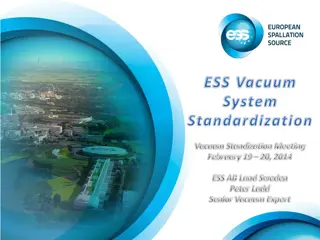Current Status of South Korea's EV Battery Recycling & ESS Industry - April 13, 2021
The article discusses the current status of South Korea's EV industry, policy direction, and the role of electric vehicles in energy storage systems. It highlights the surge in EV production by Hyundai and KIA, sales trends of green vehicles, and the Korean government's goals for EV dissemination. Additionally, it explores the challenges and opportunities in recycling EV batteries for energy storage systems.
Uploaded on Sep 19, 2024 | 0 Views
Download Presentation

Please find below an Image/Link to download the presentation.
The content on the website is provided AS IS for your information and personal use only. It may not be sold, licensed, or shared on other websites without obtaining consent from the author. Download presentation by click this link. If you encounter any issues during the download, it is possible that the publisher has removed the file from their server.
E N D
Presentation Transcript
Current Status of Koreas EV battery recycling & ESS Industry April 13, 2021 Korea Automotive Technology Institute HangKoo Lee, Executive Adviser
Todays Discussions 1. Current Status of Korea s EV Industry and Policy Direction 2. Nurturing ESS Industry using Recycled EV Battery
1. Current Status of Koreas EV Industry and Policy Direction The interest on the role of electric vehicles as energy storage system (ESS) and (electrical) energy carrier increased since the February North American winter storm that caused the largest blackouts in the U.S. since 2003, including the Texas power crisis. High-capacity batteries in EVs can store* electricity for about 10 days at home. - Can play a role in stabilizing the supply and demand of electricity during emergencies. Therefore, need to develop measures to meet the higher battery demands from increased dissemination of EVs and to reuse waste EV batteries as an ESS.
1. Current Status of Koreas EV Industry and Policy Direction Surge in the production of EVs by Hyundai and KIA: The goal is to sell 1.03 million EVs by 2025 <Table> Production and export of green vehicles by company (# of cars) Hyundai Production Export Production Kia Renault Samsung Production Export Export BEV PHEV FCEV HEV 70,487 51,989 55,553 45,900 7,325 5,346 17,087 16,387 - - 5,793 889 - - - - 107,956 61,108 95,085 41,281 - - <Table> Sales trend of green cars 2012 31,236 22,972 28,923 30,688 22,257 27,928 548 715 - - - - 2013 2014 2015 31,703 29,017 2,558 128 - 2016 52,058 74,728 93,051 110,343165,452 46,525 61,018 62,136 75,966 127,996 5,296 13,303 29,441 29,807 31,356 157 346 730 80 61 744 2017 2018 2019 2020 Total HEV BEV PHEV FCEV 995 - - 376 4,194 235 5,865 Source: Korea Automobile Manufacturers Association
1. Current Status of Koreas EV Industry and Policy Direction The Korean government has set a stretch goal for disseminating EVs. - Strengthen the sustainable growth base of battery industry, for which Korea has the strongest global competitiveness. - Solve the issues that arise at the initial commercialization phase of ESS and use the solution as a new growth engine. < Total # of green cars registered in Korea > Oct. 2020 109K 2025 93K 2021 21K Passenger vehicles 1,125 11K 6K EV Buses 7,607 193K 25K Trucks 8,895 20K 15K Passenger vehicles 16 4600 FCEV Buses 900 - Trucks 628K 1.50M HEV Passenger vehicles
2. Nurturing ESS Industry using Recycled EV Battery (Current situation) Various EV battery utilization projects are underway : V2L, which provides power to electric equipment outside V2H and V2B that provide power to buildings in situations such as blackouts V2G that stabilizes power grid - (Case 1) Vehicle-to-Load: Case of Hyundai Ionic 5 - Ionic 5 installed a V2L port under the second-row seats where the battery can be used when a vehicle is on. Up to 3.6kW of electricity can be supplied through the external V2L port with a converter while the vehicle is parked. <Using EV to provide power outside> - <Using EV to provide power to households (dcbel)>
2. Nurturing ESS Industry using Recycled EV Battery (Case 2) Samsung SDI offers the world's largest ESS to California. - In 2017, Samsung SDI , in collaboration with with global ESS companies, participated in a power grid building project in California. - Samsung SDI provided 240MWh of ESS battery, which amounted to about 70% of the total project size. (Supporting undeveloped areas) Installed Samsung SDI batteries to an alpine region of Tibet 5,000 meters above sea level - - In 2016, Samsung SDI partnered with China's PCS (Power Conditioning System) company, SunGrow, to build an eco-friendly, self-sustaining power system, using a 14MWh of ESS and 13MW of solar power plant in Tibet Plateau.
2. Nurturing ESS Industry using Recycled EV Battery Korean companies expanded ESS test centers and increased the installation of ESS to provide power to factories In 2014, POSCO ICT built ESS Test Bed. - Test Center is composed of 3 lines. - It is designed so that up to 1~4MW of power can be provided per line for testing and production - 1MW equals the amount of electricity that 1,000 households in Korea can use. Manufacturing plants implement ESS - Dongkuk Steel built an ESS center for each factory to effectively usage and to reduce electricity cost. manage electricity - Electronic companies are using ESS as well.
2. Nurturing ESS Industry using Recycled EV Battery Korean government built an EV battery recycling center on Jeju Island in 2018. - The center consists of a research building and a "inspection building" where used batteries are inspected and stored. - Jeju Island plans to switch about 400,000 registered vehicles to EVs.
2. Nurturing ESS Industry using Recycled EV Battery The central government and the local government built a cluster together: Pohang Blue Valley Cluster - Battery Recycling Hub - General processing center for secondary batteries
2. Nurturing ESS Industry using Recycled EV Battery (Growth prospect) As EV battery performance improves in the future and new business models such as battery lease spread, the utilization of EVs as an ESS and energy carriers is expected to increase as well. (Battery lease model) OEM and battery lease company can share the cost burden incurred by repeated charging and discharging of batteries such as decreased battery performance and lifetime - Long-time use batteries can be used as quick charging ESS for electric taxis (Hyundai cars) In Korea, the used batteries from EVs are expected to rise from 440 (104t) in 2021 to 78,981 (18,758t) in 2021. (KEI)
2. Nurturing ESS Industry using Recycled EV Battery If the share of renewable energy increases to more than 20-30%, as planned by the Korean government, it will become more important to expand the usage of ESS as an alternative to stabilizing the power grid - It is also expected to contribute to related industries of software, installation technology, and devices such as PCS (Power Conditioning System) and EMS(energy management system). - The key challenge is to identify causes of fire. Current status of Korea's ESS industry (MWh) 4000 3500 3000 2500 2000 1500 1000 500 0 2014 2015 2016 2017 2018 2019 2020 # of Business Place Battery Capacity
2. Nurturing ESS Industry using Recycled EV Battery (Challenge) Need to develop a measure to eliminate any uncertainties in the ESS market, after implementing safeguards against fire hazards. - According to an association comprising of 82 members, including ESS manufacturers, construction companies, operators, and relevant agencies in Korea, more than 60% of all companies continuing their businesses after fire incidents. experienced difficulties in - The number of new businesses also decreased from 973 in 2018 to 476 in 2020. - And the capacity of new facilities reached 3.7GWh in 2018 then fell to 1.8GWh in 2020. Pursuing comprehensive collaboration between Korea-EU on EV batteries and ESS. - By solving issues together, look for a win-win strategy, such as a universal international standard for the battery and ESS industries
























